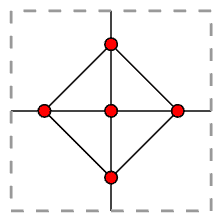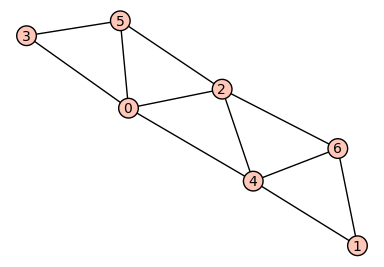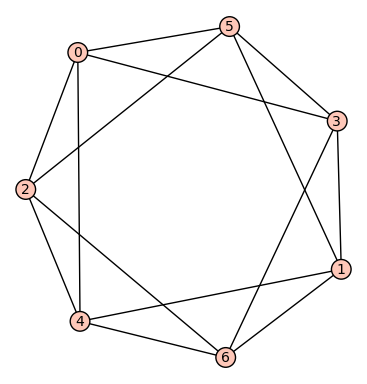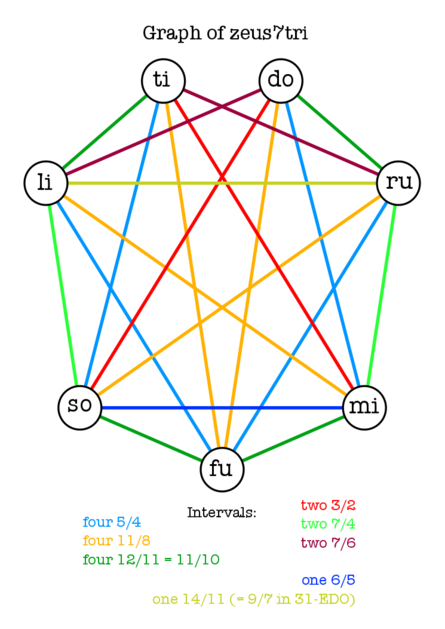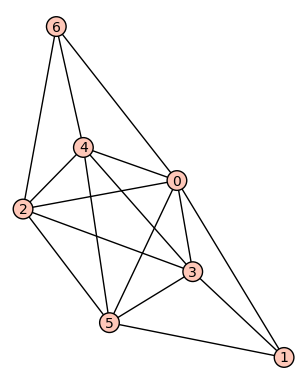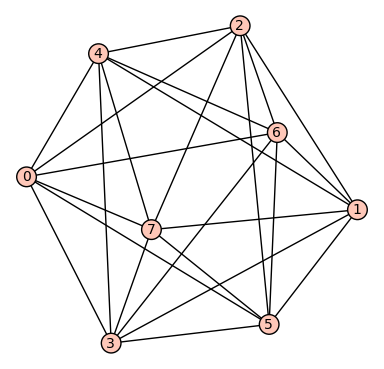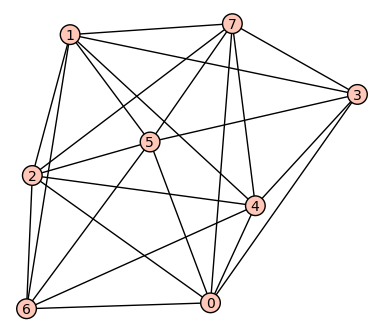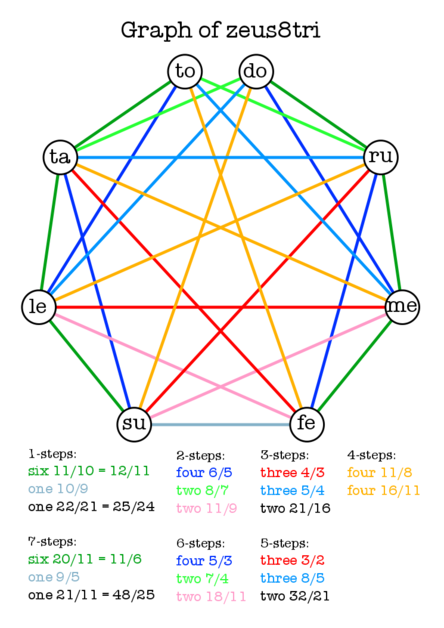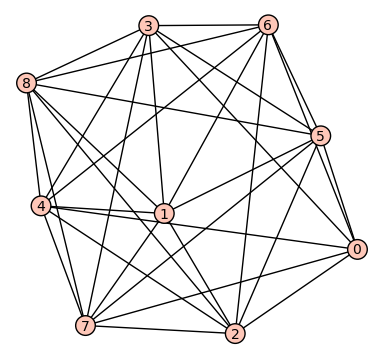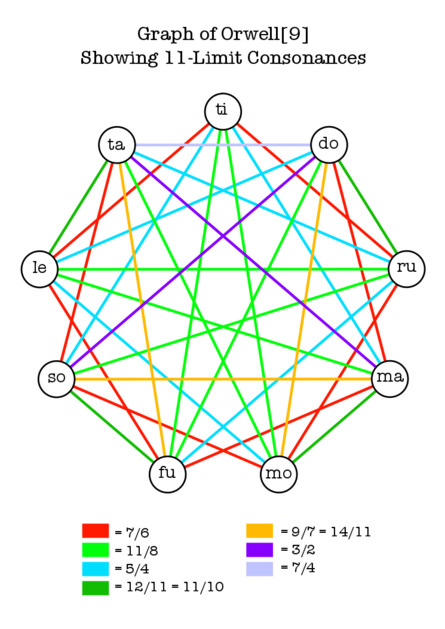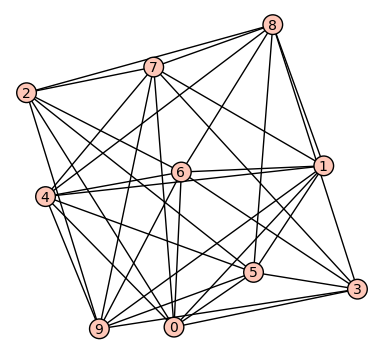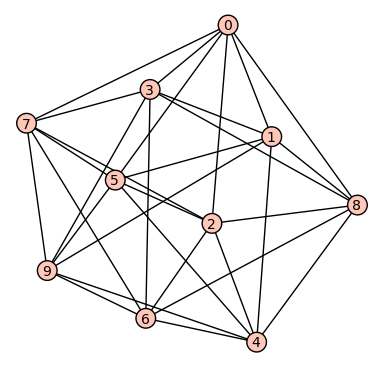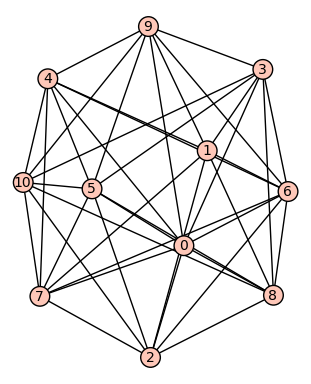Graph-theoretic properties of scales
Periodic scales can be modeled as graphs in the sense of graph theory. By applying concepts of graph theory to scales, it is possible to analyze their structure, from which some musical properties can be derived.
Graph of a scale
Given a periodic scale, meaning a scale whose steps repeat, and assuming some multiple of the period is an interval of equivalence (usually this means the octave, ie interval of 2, which from now on we will assume is the interval of equivalence) then we may reduce the scale to a finite set S of pitch classes. This relates to the usual way of defining a scale, as used for instance by Scala. If we say 1-9/8-5/4-4/3-3/2-5/3-15/8-2 is a scale, we mean that each step of it represents a class of octave-equivalent pitches, so that "5/4" represents {...5/8, 5/4, 5/2, 5, 10 ...} and both "1" and "2" mean {...1/4, 1/2, 1, 2, 4...}. Suppose we have a finite set of pitches C strictly within the octave, so that s∊C entails 1 < s < 2, and suppose if s∊C then also 2/s∊C. The elements of C represent consonant pitch classes exclusive of the unison-octave class.
We now may define the graph of the scale, which more precisely is the graph G = G(S, C) of the scale S together with the consonance set C. This means G is a (simple) graph in the sense of graph theory. The vertices of G, V(G), is the set S of pitch classes, and an edge is drawn between two distinct pitch classes r and s if X⋂C ≠ ∅, where X = {x/y|x∊r, y∊s}. This means that there is a relation of consonance, as defined by C, between the pitch classes r and s. It should be noted that we have defined things assuming pitches are given multiplicatively, but we can equally well express them in logarithmic terms as for instance by cents or by steps of an EDO.
Connectivity
We can attribute various properties to a scale, given a choice of consonance set, by the presence of a graph-theoretic property in the graph of the scale. One key graph-theoretic property is connectivity. A graph is said to be connected if for any two vertices a and b, there is a path of edges between a and b. A scale is therefore connected if you can go from any one note to any other note by means of consonant intervals only. The graph G has an edge-connectivity ε if it is possible to disconnect the graph by removing ε edges, but no smaller number of edges will do. Similarly, it has vertex-connectivity ν if it is possible to disconnect the graph by removing ν vertices (notes of the scale) but no smaller number will do. The graph is k-edge-connected if ε ≥ k, and k-vertex-connected if ν ≥ k; these definitions transfer immediately to scales, and a high degree of connectivity may often be desired in a scale.
A clique in a graph is a subgraph such that there is an edge connecting every pair of vertices; that is, the subgraph is a complete graph. In music terms, a clique is a dyadic chord. Hence, counting cliques of various degrees (number of notes) is a relevant consideration when analyzing a scale. The various problems of this nature are called, collectively, the clique problem, and this unfortunately is computationally hard. However, for scales of the size most people would care to consider a brute-force approach suffices.
Among all cliques, the maximal cliques, those not contained in larger cliques, are of special interest; they might be regarded as the basic chords of the scale. A maximum clique is a clique of largest size; these are always maximal but the converse does not always hold. Given any set of sets, we may form a graph with these as the set of vertices, by drawing an edge between any two sets with a nonempty intersection. In this way we can create graphs of all k-cliques (k note dyadic chords), maximal k-cliques, all maximal cliques, and so forth. Such graphs can illuminate harmonic relationships.
The characteristic polynomial
The adjacency matrix A of a graph is the square symmetric matrix with zeros on the diagonal, with 1 at the (i, j) place if the ith vertex is connected to the jth vertex, and 0 if it is not. The characteristic polynomial of a graph is the characteristic polynomial det(xI - A) of its adjacency matrix, and is a property (graph invariant) of the graph alone, without consideration of how the vertices are numbered. The degree n-1 term is 0, the n-2 term is minus the number of edges of the graph and therefore dyads of the scale, and the n-3 term minus twice the number of triads (3-cliques) in the graph and therefore the scale.
These properties can be also expressed in terms of the roots of the characteristic polynomial, which are the eigenvalues of the matrix. These roots are real numbers, some of which may be multiple. The spectrum of G is the multiset of roots, including multipicities, so that some roots may be repeated. From Newton's identities we can also say that the sum of the squares of the spectrum is twice the number of edges of the graph, which means twice the number of dyads of the scale, and the sum of the cubes of the spectrum is six times the number of triads of the scale. In terms of the adjacency matrix A, the number of dyads is tr(A^2)/2 and the number of triads is tr(A^3)/6, where "tr" denotes the trace. Since tr(A^2)/V, where V is the degree (number of notes) is the variance of the spectrum, we can see we prefer the variance to be larger rather than smaller. Also, tr(A^3)/V divided by the 3/2 power of the variance is the skewness of the spectrum, from which we can conclude we want the skewness to skew positive.
The epitome of these properties is found in the complete graph, which in scale terms means every note is in consonant relation with every other--in other words, the scale is a dyadic chord. This has a spectrum with V-1 values of -1 and one of V-1. The distance between two vertices (notes) is the number of edges (consonant intervals) of the shortest path between then, and the diameter of a graph is the length of the greatest distance between two vertices, while the radius is the minimax distance--the minimum over all vertices of its maximum distance to any other vertex. The diameter of a compete graph is 1, and in general a small diameter is another desirable quality. A graph with diameter d must have at least d+1 distinct values in the spectrum.
The Laplace spectrum
If D is the diagonal matrix [Dij], with Dii being the degree of the ith vertex--that is, the number of edges connecting to that vertex--then L = D - A is called the Laplace matrix of the graph G, and its eigenvalues (roots of its characteristic polynomial) is the Laplace spectrum. The matrix L is positive-semidefinite; the Laplace spectrum has at least one zero value, with the other values real and non-negative; the number of zero values in the Laplace spectrum is equal to the number of connected components of G, and so there is just one iff G is connected. The second smallest member λ of the Laplace spectrum, which is therefore positive iff G is connected, is called the algebraic connectivity. The various kinds of connectivity are related by the inequality λ ≤ ν ≤ ε; that is the algebraic connectivity is less than or equal to the vertex connectivity, which is less than or equal to the edge connectivity. In the other direction, λ ≥ 2(1 - cos(π/V))ε, where V is the number of vertices; consequently λ > (π/V)^2 ε.
We can also relate the diameter d to the algebraic connectivity, since 4/(Vλ) ≤ d ≤ 2((Δ+λ)/4λ)ln(V-1), where Δ is the maximal degree of the vertices of G. Also, if ρ is the mean distance, meaning the average of all of the distances in G, then 2/((V-1)λ) + (V-2)/(2(V-1)) ≤ ρ ≤ (V/(V-1))((Δ+λ)/4λ)ln(V-1). Hence when λ is small, distances will be large.
The sum of the Laplace spectrum, which is tr(L), is twice the number of edges (dyads). Just as with the ordinary spectrum, the Laplace spectrum has at least d+1 distinct values for a graph of diameter d. The largest value in the Laplace spectrum is less than or equal to V, the degree of the graph, meaning the size of the scale; and is equal iff the complementary graph is disconnected, where the complementary graph is the graph of non-consonant relations, that is, the graph which has an edge between two vertices iff G doesn't.
The genus
A graph is planar if it can be drawn on a plane, or equivalently on a sphere, in such a way that no edges cross. Not all graphs can be drawn without edge crossings on a sphere, but they all can be drawn without crossings on a suitable compact orientable surface with "donut holes", which we may view as a closed and bounded surface in 3 dimensional Euclidean space. If a surface has g holes, it is of genus g, where the sphere (or plane) has genus 0. The minimum number of holes needed to draw the graph is the genus of the graph.
Drawing (embedding) the graph on a surface with no crossings would give a nice visual picture of the harmonic relations in a scale. Moreover, such an embedding can be converted into a planar diagram by allowing the depiction of some of the vertices in more than one place, on the edge of the diagram. Unfortunately, the problem of determining the genus and finding such an embedding is NP-complete. However, finding bounds on the genus is a much easier problem. For very small scales, the genus routine of SAGE can manage to finish computing after an acceptable amount of time.
If the genus is g, the graph can also be drawn on any surface of genus greater than g; one way to accomplish that, but not the only way, is simply not to use more than g of the holes--that is, not to draw an edge passing through it. In fact, beyond a certain point you would not be able to use all of the holes and would have to leave some without edges drawn through them. The maximum number of holes, all of which can actually be used by having an edge pass through them, is called the maximal genus and is another invariant of the graph.
A 5-limit JI scale, meaning a scale composed of 5-limit JI intervals such that {6/5, 5/4, 4/3, 3/2, 8/5, 5/3} is the consonance set, is always planar. This because the hexagonal lattice of 5-limit pitch classes is planar, and the graph of any scale will simply be a finite subgraph of that lattice, considered as a graph. On the other hand, a non-contorted 5-limit scale in any equal temperament will be of genus 1, since the two commas serve as boundaries for a parallelogram which defines a torus (we can visualize this as rolling it up and glueing ends together.)
A dyadic chord pentad is of genus 1, and any scale containing dyadic pentads is therefore not planar. The embedding of a pentad's graph on a torus is illustrated below:
The edges leading from the four outer vertices wrap around to the opposite side, creating the torus embedding. On the other hand, a tetrad is of genus 0, since it can be drawn on a sphere as the verticies of a tetrahedron.
If V is the number of notes (vertices) of the scale, and E the number of dyads (edges), then the maximum value for E is C(V, 2) = V(V - 1)/2. This suggests the definition for graph density, 2E/(V(V-1)). Since the maximum number of edges for a genus 0 graph with V>2 is 3V - 6, the maximum density for a genus 0 graph is 6(V-2)/(V(V-1)) which has series expansion 6/V - 6/V^2 - 6/V^3 ...; if the density is 6/V or greater the graph must be of a higher genus, hence, higher genus scales are to be expected in music. If each note is harmonically related to at least three other notes, an obviously desirable property which in graph-theoretic language means the minimum degree is greater than two, then the genus g ≥ E/6 - V/2 + 1. On the other hand, for a connected graph we have g ≤ (E - V + 1)/2
The automorphism group
If A is the adjacency matrix, which is a VxV square matrix, the automorphism group Aut(G) of the graph G is given explicitly by the set {P|P⋅A = A⋅P} of VxV permutation matrices which commute with A. Equivalently, it is the set {P|A = P⋅A⋅P^(-1)}, where A is identical to itself under a similarity transformation. For most graphs, the automorphism group is trivial; however this is often not the case for graphs of scales. For instance, a symmetric scale such that if s is in the scale, then so is its octave inversion 2/s, will have an element of order 2 in its automorphism group. A MOS will always have an element of order 2, resulting from some composition of inversion and translation. Graph automorphisms such as these preserve the property of being a dyadic chord, making such things of considerable musical interest.
If the spectrum of the graph contains no repeated values, then Aut(G) is an elementary abelian 2-group, meaning all non-identity elements are of order 2. Hence for the more interesting automorphism groups, including non-abelian groups, we need repeated values in the spectrum; in other words eigenvalues with multiplicity greater than one corresponding to eigenspaces with dimension greater than one.
Edge-labeled tuning
An edge-labeled graph is a graph with a function from its edges to a set of "labels". Ordinarily, this function is a bijection, but for our purposes we allow different edges to have the same label. Instead, we take the labels to be the intervals which are the intended targets for the scale tuning. The pitch classes denoted by a and b have representatives in the octave 1 < z ≤ 2, which by abuse of notation we will also call a and b, and assume 1 < a < b ≤ 2. The edge {a, b} then has a target interval 1 < z < 2, or 0 < z < 1200 in terms of cents, where b/a is approximately z (or b-a is approximately z if we are working additively in terms of cents.) In the simplest case, the target intervals are members of our consonance set. If we want to approximate more than one interval in our consonance set by a given edge, for instance both 10/9 and 9/8 in a temperament in the meantone family, we can replace the set of approximate consonances by a suitable average, such as the geometric mean.
An edge-labeled tuning is now definable as a tuning derived by optimizing the fit to the target interrvals of the edges. This could be, eg, a minimax optimization, but the simplest to compute and a good practical choice is to take the least squares edge-labeled tuning, where the intervals are expressed in terms of cents. In many cases this will result in a lesfip tuning. This result is both a good practical tuning, and a reasonable choice for a canonical tuning if such a thing is needed.
Seven-note scales
The Zarlino scale
The Zarlino scale, or "just diatonic" as it's often called, is the scale 1-9/8-5/4-4/3-3/2-5/3-15/8-2, with three major and two minor triads. It has a characteristic polynomial x(x+1)(x^2-3)(x^3-x^2-7*x-3) = x^7 - 11x^5 - 10x^4 + 21x^3 + 30x^2 + 9x. From the coefficients of this we can read off that it has 11 dyads and 5 triads, and from the roots, we find that its automorphism group is an elementary 2-group--in fact, it is of order 2, with the nontrivial automorphism being inversion. The three connectivities, algebraic, vertex, and edge, are 0.914 ≤ 2 ≤ 2. The scales radius is 2 and its diameter is 3. Its genus, of course, is 0, but less obviously its maximal genus is 2.
The diatonic scale (Meantone[7])
The diatonic scale in 31edo consists of the notes 0, 5, 10, 13, 18, 23, 28, 31. In the 7-limit, it has the consonance set {6, 7, 8, 10, 13, 15, 16, 18, 21, 23, 24, 25}, leading to a graph with the high degree of symmetry afforded by the dihedral group of order 14. This graph is in fact isomorphic to the graph of 5-limit 7edo. The maximal cliques of the graph are the seven dyadic chord triads, one on each degree of the scale; three major, three minor, and one diminished. Because of the graph symmetry, the 7-limit diatonic scale can transpose to any key, mapping all dyadic triads to other dyadic triads.
The genus of the 7-limit diatonic scale is 1, with maximal genus of 4. The connectivities go 3.198 ≤ 4 ≤ 4, and the radius and diameter are both 2.
Gypsy
Gypsy is the tempering in 7-limit marvel of the JI scale 16/15, 5/4, 4/3, 3/2, 8/5, 15/8, 2. This scale is mavchrome1, the first 25/24&135/128 Fokker block, and is also the 5-limit, 7-note JI hobbit, or "jobbit". It is also Helmholtz's Chromatic and the Slovakian gypsy major. Another mode is the Slovakian gypsy minor, noted by Tartini, and still another mode is the tempering of a 7-limit scale due to Dave Keenan, keenanjust. Last but hardly least, it is the tempering of the 7-limit scale listed in the Scala catalog as "al-farabi_chrom2", and is derived from a permutation of Al Farabi's chromatic tetrachord 7/6-15/14-16/15. This kind of tetrachordal permutation was a part of the medieval Islamic theory.
However arrived at, the scale in 197et is 0, 19, 63, 82, 115, 134, 178, 197. It has two graphs of interest, since the graphs of 7-limit relations and of 9-limit relations are not isomorphic, but the automorphism groups (of order 16) of these graphs are. The 7-limit consonance set is {38, 44, 52, 63, 82, 96, 101, 115, 134, 145, 153, 159, 197} and the 9-limit set is {30, 33, 38, 44, 52, 63, 71, 82, 96, 101, 115, 126, 134, 145, 153, 159, 164, 167, 197}. The difference is {30, 33, 71, 126, 164, 167}. In Gypsy, the 9-limit intervals occur between 5/4 and 8/5, tempered to 9/7, and between 4/3 and 3/2.
If we call the automorphism group of the 7-limit graph G7 and that of the 9-limit group G9, then G7 is guaranteed to send 7-limit intervals to 7-limit intervals, but will not necessarily send 9-limit intervals to a consonance. G9 must send 9-limit intervals to 9-limit intervals, but may send a 7-limit interval to the 9-limit. The intersection G7∩G9 is a group of order eight which sends 7-limit intervals to 7-limit intervals, and strictly 9-limit intervals, those of Kees height 9, to strictly 9-limit intervals; it can't send such intervals to the 7-limit without the inverse sending a 7-limit interval to the 9-limit. G7∩G9 = {0123456, 0132546, 0145236, 0154326, 0623451, 0632541, 0645231, 0654321}, G7\G9 = {0125436, 0134526, 0143256, 0152346, 0625431, 0634521, 0643251, 0652341}, and G9\G7 = {0123546, 0132456, 0145326, 0154236, 0623541, 0632451, 0645321, 0654231}. G7 and G9 are intransitive; one orbit consists of the fixed center interval 0, and an involution exchanges the extreme intervals 0 and 6. The other four points are permuted by the group of the square in two different representations for G7 and G9.
The 9-limit graph has eight maximal cliques, four triads, each containing 0, and four tetrads, each containing both 1 and 6. The triads consist of 0 plus any of the dyads {2, 4}, {2, 5}, {3, 4} or {3, 5}, and the tetrads consist of {1, 6} plus any of the same set of dyads. The genus of both the 7-limit and the 9-limit graphs is 1.
Marvel11max7a
Like Gypsy, marvel11max7a is a consonant class scale for marvel, based on the fact that four 5/4s, two 6/5s and one 8/7 come to four times 225/224, and these are approximately the intervals in the second consonance class, in the order 5/4, 6/5, 5/4, 6/5, 8/7, 5/4, 5/4, leading to a scale which is the marvel tempering of 9/8, 5/4, 32/25, 3/2, 8/5, 15/8, 2. In 166et, this becomes 0, 28, 53, 60, 97, 113, 150, 166, with 11-limit consonance set {21, 23, 25, 28, 32, 37, 44, 48, 53, 58, 60, 69, 76, 81, 85, 90, 97, 106, 108, 113, 118, 122, 129, 134, 138, 141, 143, 145, 166}.
The first scale element, the approximate 9/8, is exceptional in having a consonant relation to all other notes. The other six notes make a symmetric graph in the form of an octahedron, and they, as well as the full scale graph, have the automorphism group of the octahedron, of order 48. The note pairs (0 6), (2 3) and (4 5) represent opposite verticies of the octahedron, not connected by a consonance, and give involutions in the automorphism group. The full automorphism group itself is generated by (2,3), (4,5), (2,4)(3,5) and (0,2)(3,6).
The faces of the octahdron, [0, 2, 4], [0, 2, 5], [0, 3, 4], [0, 3, 5], [2, 4, 6], [2, 5, 6], [3, 4, 6], [3, 5, 6], are of course triads, and each of them can be extended to a tetrad by adding note 1, leading to the eight maximal cliques of the scale. The connectivities of the scale are 5 ≤ 5 ≤ 5, which is maximal among all seven-note marvel tempered scales save for the fact that the inversion of marvel11max7a, which is marvel11max7b, has of course an isomorphic graph. The count of dyads and triads is also maximal. The genus of the graph is 1.
Zeus7tri
Zeus7tri is the tempering in zeus of 11/10, 5/4, 11/8, 3/2, 12/7, 15/8, 2. In 99et it has steps 0, 13, 32, 45, 58, 77, 90, 99, with an 11-limit consonance set {13, 13, 15, 17, 19, 22, 26, 28, 32, 35, 36, 41, 45, 48, 51, 54, 58, 63, 64, 67, 71, 73, 77, 80, 82, 84, 86, 86}. The scale contains two maximal hexads, consisting of the pentad of the notes 1 through 5 plus either 0 or 6. The automorphism group is of order 240, consisting of the direct product of the group of order two exchanging 0 and 6, and the symmetric group on the five other notes 1, 2, 3, 4, 5. It has vertex, edge and algebraic connectivities all 5.
The scale is interesting in that it has the trivalent property, so that there are exactly three specific intervals for each generic interval save the octave multiples. It is a consonant class scale, with class 2 containing the three thirds, 7/6, 6/5 and 5/4.
Archchro
Archchro is the tempering in hemif, a 2.3.7.11.13 subgroup scale, of Archytas' Chromatic. In the 58et tuning, it has steps of 0, 3, 10, 24, 34, 37, 44, 58, with a consonance set {6, 7, 10, 11, 13, 14, 17, 20, 21, 24, 27, 31, 34, 37, 38, 41, 44, 45, 47, 48, 51, 52}. Archchro is intransitive, with one orbit consisting of notes 2, 3, and 6, and the other of notes 0, 1, 4 and 5. The three note orbit is permuted by the group of the triangle, which is to say, the symmetric group S3, and the four note orbit by the group of the square. Together these give an automorphism group of order 6 X 8 = 48. The eight permutations fixing 2, 3, and 7 are {0123456, 0123546, 1023456, 1023546, 4523016, 4523106, 5423016, 5423106}, and the six fixing 0, 1, 4 and 5 are {0123456, 0126453, 0132456, 0136452, 0162453, 0163452}.
Archchro has four maximal cliques, the pentads 02346, 02356, 12346, and 12356. Its graph has edge, vertex and algebraic connectivity all 5, a radius of 1 and a diameter of 2, and is of genus 1.
Elfjove7
Elfjove7 is the seven note elf scale of jove temperament, the 11-limit temperament rank three tempering out 243/242, 441/440, 540/539 and 2401/2400. In the 202et tuning, it has steps 0, 39, 59, 84, 118, 143, 163, 202, with a consonance set {25, 28, 31, 34, 39, 45, 53, 59, 65, 70, 73, 84, 93, 98, 104, 109, 118, 129, 132, 137, 143, 149, 157, 163, 168, 171, 174, 177}. The permutation group of automorphisms is intransitive, with orbits {0}, {1, 6} and {2, 3, 4, 5}. The group is the group of the square, acting transitively on the {2, 3, 4, 5} orbit. The permuations of the {2, 3, 4, 5} square Identity, (24), (35), and (24)(35) leave 1 and 6 fixed, and the permutations (2345), (23)(45), (2543) and (25)(43) exchange the pair.
Elfjove7 has three maximal cliques, the pentad 02345 and the two tetrads 0135 and 0246. The scale is a tempering of the transversal 1-8/7-11/9-4/3-3/2-18/11-7/4-2, and so the maximal cliques are temperings of 1-11/9-4/3-3/2-18/11, 1-8/7-4/3-18/11 and 1-11/9-3/2-7/4, which are essentially tempered chords.
Elfjove7 has an edge and vertex connectivity of 3, a radius of 1 with a diameter of 2, and is of genus 1.
Jupiter's Rations by Andrew Heathwaite
Eight-note scales
Star
Star is a scale of 11-limit valentine temperament, which in 77et is 0, 5, 20, 25, 40, 45, 57, 65, 77, with the 11-limit consonance set {10, 12, 13, 15, 17, 20, 22, 25, 27, 28, 32, 35, 37, 40, 42, 45, 49, 50, 52, 55, 57, 60, 62, 64, 65, 67}. Its eight vertices are connected via 24 edges; in four dimensions this can be identified as the eight verticies and 24 edges of the 16-cell, or hexadecachoron, a four-dimensional regular polytope. The scale exhibits a very high degree of symmetry, with an automorphism group of order 384, the 8T44 transitive group S2≀S4. Star has a 9-limit twin scale, Nova, with an isomorphic graph, which means all the statements about Star in this section, except for the fact that it is 11-limit, are equally true of Nova.
The graph of Star is 6-regular, with every vertex connected to six others (on the 16-cell only opposite verticies fail to connect), and its algebraic, vertex and edge connectivities are all 6. The largest element of the Laplace spectrum is 8, so its complementary graph is not connected, it consists of the four edges connecting opposite verticies of the 16-cell. It has 16 maximal cliques, all of which are tetrads, corresponding to the 16 cells of the 16-cell, and 32 triads extendable to these tetrads, corresponding to the 32 triangular faces of the 16-cell. The graph of the maximal cliques is 14-regular, with each tetrad linking to all others but its relative complement in the whole scale, that is the set of notes from note 0 to note 7, the "opposite vertex". The relative complement of each dyadic tetrad is also a dyadic tetrad. The graph is known to be of genus 1, so it can be drawn on a square with opposite edges identified.
The first note of any of the 16 tetrads of Star can be either 0 or 1, the second 2 or 3, the third 4 or 5, and the fourth 6 or 7. Any of the resulting 16 possible combinations will not have the forbidden intervals (0, 1), (2, 3), (4, 5), or (6, 7) which are too small to give 11-limit consonances.
Oktone
By Oktone is meant the tempering of the octone scale, 1-15/14-60/49-5/4-10/7-3/2-12/7-7/4-2, in jove temperament. The tempering can be accomplished via 202et, leading to the scale 0, 20, 59, 65, 104, 118, 157, 163, 202 which we can use together with the 11-limit diamond as a consonance set, {25, 28, 31, 34, 39, 45, 53, 59, 65, 70, 73, 84, 93, 98, 104, 109, 118, 129, 132, 137, 143, 149, 157, 163, 168, 171, 174, 177}. This leads to a highly accurate scale with a good deal of symmetry. The automorphism group of the graph is the direct product of the group of the square with an involution, ie an element of order two. The involution simultaneously exchanges notes 2 and 7, and 3 and 6; that is, it is in cycle terms (2, 7)(3,6), or (59, 163)(65, 157) in terms of 202et, and the square part permutes the cycle (0, 4, 1, 5) by the group of the square.
The graph has twelve maximal cliques, all tetrads, of which four connect with all of the other tetrads, and eight connect with all but one. It has two vertices of degree five and six of degree six, with connectivities 4.586 ≤ 5 ≤ 5, and radius and diameter both 2.
Zeus8tri
Zeus8tri is the tempering in zeus of [11/10, 6/5, 21/16, 16/11, 8/5, 7/4, 21/11, 2]. In 99et, that leads to scale steps of 0, 13, 26, 39, 54, 67, 80, 93, 99, with the same consonance set as zeus7tri. The automorphism group is of order 48, the direct product of an involution (0,7)(3,4) and the symmetric group on the four elements in the center (in the sense of graph theory) of the graph, {1, 2, 5, 6}. It has connectivities 4.586 ≤ 5 ≤ 5, a radius of 1 and a diameter of 2.
Zeus8tri has three maximal cliques, the hexads [0, 1, 2, 4, 5, 6], [1, 2, 3, 4, 5, 6], [1, 2, 3, 5, 6, 7], each of which consists of the four notes in the center plus {0, 4}, {3, 4}, or {3, 7}. Instead of having a single circle of thirds like zeus7tri, it has two, both of which are the 15-limit valinorsmic tetrads with steps 6/5, 11/9, 6/5, 8/7 which we have not counted among the (11-limit) chords of zeus8tri. Adding 126/125 to the commas of zeus leads to valentine temperament, which does not damage the tuning accuracy of zeus very much. In valentine, zeus8tri becomes a scale of Graham complexity 13, with generator steps -7, -5, -3, -1, 0, 2, 4, 6.
Nine-note scales
Orwell[9]
Orwell[9], the 9-note orwell MOS, has notes 0, 5, 12, 17, 24, 29, 36, 41, 48, 53 in 53et. With the 11-limit consonance set {7, 8, 9, 10, 12, 14, 15, 17, 19, 22, 24, 26, 27, 29, 31, 34, 36, 38, 39, 41, 43, 44, 45, 46} it defines a graph of 31 edges with an automorphism group of order 96. The group consists of an octahedronal group part which is transitive on the six notes from 2 to 7, that is {12, 17, 24, 29, 36, 41} of 53edo, generated by (2,3), (4,5),(6,7), (2,4)(3,5) and (4,6)(5,7), and an involution exchanging notes 1 and 8, that is, 5 and 48 of 53edo. The center of the MOS, note 0 in this numbering, stays where it is, and has degree six whereas all the other notes are degree seven.
The graph has 16 maximal cliques, eight tetrads and eight pentads. All of the tetrads contain note 0, and all of the pentads notes 1 and 8. All three connectivites equal 6, the radius and diameter are both 2, and the graph complement is disconnected.
graph of orwell-9 color-coded.pdf
Mountain Village by Tarkan Grood
Swing in Orwell-9 by Gene Ward Smith
Godzilla[9]
The symmetric mode of the 9-note godzilla MOS has notes 0, 3, 4, 7, 8, 11, 12, 15, 16, 19 in 19et, with 11-limit consonance set {2, 3, 4, 5, 6, 7, 8, 9, 10, 11, 12, 13, 14, 15, 16, 17}. Its graph has 32 edges, and its automorphism group is the same as that of star and nova--the group of the 16-cell, S2≀S4, the 8T44 transitive group of order 384. The graph can be drawn in four dimensions as the eight verticies of the 16-cell, plus another vertex in the center connecting with all of the rest, and corresponding to note 0, the center note of the MOS. The sixteen tetrads of star or nova correspond to sixteen pentads of Godzilla[9], which each add note 0 to the choice of notes 1 or 2, 3 or 4, 5 or 6, and 7 or 8. It has algebraic, edge, and vertex connectivities all 7. Godizlla[9] is a consonant class scale in multiple ways, skipping only class 1 and class 8.
Ten-note scales
Magic[10]
Magic[10], the 10-note MOS of magic temperament, can in 104et be expressed as the scale 0, 23, 28, 33, 38, 61, 66, 71, 94, 99, 104. If we use the 11-limit diamond, {13, 15, 15, 18, 20, 23, 28, 30, 33, 36, 38, 43, 48, 51, 53, 56, 61, 66, 68, 71, 74, 76, 81, 84, 86, 89, 89, 91}, for consonances we get a graph with ten verticies and 34 edges, with algebraic, vertex, and edge connectivity all 6. Its radius and diameter are both 2. It has 27 maximal cliques, 18 triads and 9 tetrads.
Abstractly, the rather large group of automorphisms of order 288 is the direct product of the Klein four-group and the transitive group 6T13 of degree 6, which is the wreath product S3 ≀ S2. The four-group part acts on the notes from 1 to 4, and is generated by the involutions (1,4) and (2,3), and the 6T13 group, of order 72, acts on notes 5 through 10--or 5 through 9 and 0, if you prefer. It is generated by (5,10)(6,8)(7,9) together with (5,6), (6,7) and (8,9).
The dekany
The standard 2)5 dekany is a combination product set, Cps([2,3,5,7,11], 2). It consists of ten notes associated to two-element subset of the set of the first five primes, {2,3,5,7,11}, and in one mode is 1-12/11-5/4-14/11-15/11-3/2-35/22-7/4-20/11-21/11, which we will take as its notes from note 0 to note 9. It has 30 edges, with connectivities 5 ≤ 6 ≤ 6, and the largest element of the Laplace spectrum is 8, so that the complementary graph is also connected. Its radius and diameter are both 2. The graph is known as the Johnson graph J(5,2). The 3)5 dekany, which is the inverse of the standard dekany, has the Johnson graph J(5,3) as its graph, which is graph-isomorphic to J(5,2).
The automorphism group is S5, the symmetric group of order 120 on a set of five points, which in this case are the five prime numbers 2 to 11. Any permutation acts faithfully on the notes of the dekany, inducing the transitive permutation representation called 10T13 of S5 on ten points. The dekany has five maximal 4-cliques (tetrads) and ten maximal 3-cliques (triads), and S5 acts faithfully on these also. The graph of triads is isomorphic to the graph of the scale, and the graph of tetrads is the complete graph on five vertices K5; both have automorphism group S5.
Though it has only ten notes, an attempt to compute the genus of the dekany using SAGE caused it to wander off into the weeds and never return, or at least not when it was allowed to run overnight. An inquiry of someone who has published on the Johnson graphs revealed he had no idea what the genus of J(5,2) was, and it may very well not be known. However, the inequalities above show the genus must be at least 1.
Eleven-note scales
Myna[11]
Myna[11], the 11-note MOS of myna, can be specified in the 89et tuning as the notes 0, 3, 20, 23, 26, 43, 46, 63, 66, 69, 86, 89. Using the 11-limit diamond as a consonance set gives a graph with 40 edges corresponding to 40 dyads. Its connectivities are 6 ≤ 7 ≤ 7, It has eight vertices of degree 7, and three of degree 8, with a radius and diameter both 2.
The automorphism group of order 24 is the direct product of an involution and the group of the hexagon, which act on disjoint notes of the scale. The involution is (0,1)(5,6) and the hexagon group (dihedral group of order 12) permutes the cycle (2,7,4,9,3,8); this cycle together with the two involutions (2,3),(7,9) and (3,4),(7,8) generate the hexagon group.
Twelve-note scales
The Marveldene
The Ellis Duodene is the 12-note 5-limit scale 1-16/15-9/8-6/5-5/4-4/3-45/32-3/2-8/5-5/3-9/5-15/8-2, and marvel tempering it leads to the Marveldene. An excellent tuning for marvel is 166et, and in that the scale becomes 0, 16, 28, 44, 53, 69, 81, 97, 113, 122, 141, 150, 166. If we use the 15-limit consonance set, {16, 18, 19, 21, 23, 25, 28, 32, 34, 37, 40, 44, 48, 50, 53, 58, 60, 63, 69, 74, 76, 78, 81, 85, 88, 90, 92, 97, 103, 106, 108, 113, 116, 118, 122, 126, 129, 132, 134, 138, 141, 143, 145, 147, 148, 150}, we obtain a graph with 55 edges and an automorphism group of order 32. Abstractly, the automorphism group is the direct product of the group of the square with the Klein four-group; as a permutation group it is the square (dihedral group D8 of order 8) part, generated by {(1,2)(5,6)(8,11)(9,10), (1,5), (2,6)}, and the two involutions flipping two notes, (3,4) flipping Eb and E, and (7,12) flipping C and G.
The connectivites of the Marveldene go 6.222 ≤ 7 ≤ 8, and it has a radius of 1 and a diameter of 2, with center {0, 7}, ie C and G. The largest element of the Laplace spectrum is 12, so the complementary graph is not connected. It has eight maximum cliques, the septads [0, 1, 3, 5, 7, 8, 11], [0, 1, 3, 5, 7, 9, 11], [0, 1, 4, 5, 7, 8, 11], [0, 1, 4, 5, 7, 9, 11], [0, 2, 3, 6, 7, 8, 10], [0, 2, 3, 6, 7, 8, 11], [0, 2, 4, 6, 7, 8, 10] and [0, 2, 4, 6, 7, 8, 11], and two maximal pentads, [0, 3, 7, 9, 10] and [0, 4, 7, 9, 10].
The Novadene
The 5-limit Fokker block 1-27/25-10/9-6/5-5/4-4/3-36/25-3/2-8/5-5/3-9/5-48/25-2, which has been called the skewed duodene or magsyn3, serves as a transversal for the Novadene, which in 185et is 0, 19, 29, 48, 60, 77, 96, 108, 125, 137, 156, 173, 185 with consonances the 9-limit diamond, 29, 31, 36, 41, 48, 60, 67, 77, 89, 96, 108, 118, 125, 137, 144, 149, 154, 156.
The graph of Novadene has 46 edges between its 12 vertices, and an automorphism group of order 48 isomorphic to the group of the octahedron. The automorphisms permute the four notes with note-number divisible by 3, namely 0, 3, 6 and 9, in all 24 possible ways and the other vertices in 48 ways, so there are two separate orbits. The degrees of 0, 3, 6 and 9 are 9, and of the other verticies 7. It has algebraic, vertex and edge connectivities of 5 ≤ 7 ≤ 7, and a radius and diameter both 2. It has four pentads which are its maximum cliques, and 23 other maximal cliques in the form of tetrads.
It should be noted that the Novadene has a couple of 14/11 thirds which are four cents sharp, and it makes sense to count them among the consonances of Novadene; however, doing so makes the graph less symmetrical.
Thirteen-note scales
Magic[13]
Magic[13] is the 13-note MOS of magic temperament, which in 104et has notes 0, 5, 10, 28, 33, 38, 43, 61, 66, 71, 76, 94, 99, 104. Using the 11-limit diamond, {13, 15, 15, 18, 20, 23, 28, 30, 33, 36, 38, 43, 48, 51, 53, 56, 61, 66, 68, 71, 74, 76, 81, 84, 86, 89, 89, 91} as the consonance set, we obtain a graph on 13 notes with 61 edges representing dyads. It has algebraic, vertex and edge connectivities all 8, and a disconnected graph complement. The radius and diameter are both 2.
It has a disparate collection of 36 maximal cliques ranging from triads to hexads, and an automorphism group which abstractly is the direct product of two square groups. However, as a permutation group the two cycles on which the automorphisms act as the square group, (3, 7, 6, 10) and (4, 8, 5, 9), don't appear in isolation, and the group actually moves everything but the central note of the MOS, note 0 in this labeling.
Orwell[13]
Orwell[13], the 13-note MOS of orwell, has four more notes but the same set of 11-limit consonances as Orwell[9]. Now we have 0, 5, 7, 12, 17, 19, 24, 29, 34, 36, 41, 46, 48, 53, and while the graph of the scale still has a lot of symmetry, it is of an entirely different kind. This time the symmetry group is analogous to that of the diatonic scale, being the dihedral group D26 on 13 points; as with the 7-limit diatonic scale, the symmetries of Orwell[13] appear as inversion and the ability to transpose to any key while retaining the dyadic character of all dyadic chords, which however are much more numerous in kind and number. In particular, Orwell[13] has 26 maximal pentads and 13 maximal hexads on which the automorphism group faithfully acts.
The graph of Orwell[13] is 10-regular, has 65 edges, with connectivities 9.058 ≤ 10 ≤ 10, and radius and diameter both 2.
